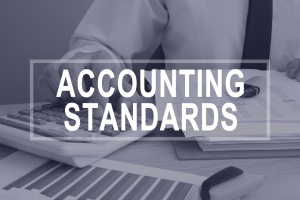عرض العناصر حسب علامة : معايير محاسبة
رسالة ماجستير: مدى التزام مؤسسة المدن الصناعية الأردنية بتطبيق المعايير الدولية للتقارير المالية
هدفت هذه الدراسة إلى التعرف على مفهوم معايير المحاسبة والإبلاغ المالي الدولية وتفسيراتها ونطاق تطبيقها ومدى التزام وتقيد مؤسسة المدن الصناعية الأردنية ذات الاستقلال المالي والإداري بتطبيقها عند إعداد التقارير المالية وكيفية إجراءات التطبيق من حيث (القياس، والاعتراف، والعرض، والإفصاح).
معلومات إضافية
- البلد الأردن
رسالة دكتوراه: أثر الملكية الإدارية على العلاقة بين إدراج الشركات بالمؤشر المصري للمسئولية الاجتماعية وكفاءة الاستثمار
الهدف: اختبار أثر إدراج الشرکات بالمؤشر المصرى للمسئولية الاجتماعية (S&P/EGX ESG Index) على کفاءة استثمارتها، بالإضافة إلى اختبار مدى اختلاف هذه العلاقة التأثيرية باختلاف الملکية الإدارية.
معلومات إضافية
- البلد مصر
الاتصال والعمل الأساسي والتقارب -ما التالي لمعايير المحاسبة الدولية لإعداد التقارير المالية؟
ألقى أندرياس باركو، رئيس مجلس معايير المحاسبة الدولية (IASB)، كلمة أمام المندوبين في مؤتمر AICPA وCIMA حول التطورات الحالية لـ SEC وPCAOB في 7 ديسمبر في واشنطن. في خطابه، أوجز أولويات IASB الفورية والمستقبلية، وتحدث عن الأهمية المتزايدة لقضايا الاستدامة في التقارير المالية وتبادل وجهات نظره حول التقارب مع FASB.
معلومات إضافية
-
المحتوى بالإنجليزية
Connectivity, core work and convergence—what next for IFRS Accounting Standards?
Barckow Andreas
Andreas Barckow, Chair of the International Accounting Standards Board (IASB), addressed delegates at the AICPA and CIMA Conference on Current SEC and PCAOB Developments on 7 December in Washington. In his speech, he outlined the IASB’s immediate and future priorities, talked about the growing importance of sustainability issues in financial reporting and shared his views on convergence with the FASB.
Good afternoon, it is a pleasure to be with you today. My name is Andreas Barckow, and since July this year I have served as Chair of the International Accounting Standards Board, or IASB. The IASB is the independent standard-setting board of the IFRS Foundation, which is responsible for IFRS Accounting Standards required for use by more than 140 countries.
Although US companies are required to use US GAAP, many have international subsidiaries that report using IFRS Accounting Standards. Moreover, US investors investing internationally are prolific users of financial statements that comply with IFRS Accounting Standards. Your views matter to us, so please continue getting involved in our work.
Given the role IFRS Accounting Standards play in United States, I’ll focus my comments on three strategic topics: sustainability, our current and future work programme and convergence.
Sustainability-related financial disclosures
First off is sustainability. It might seem odd for the Chair of the IASB to begin by talking about sustainability. However, the principle-based nature of IFRS Accounting Standards means that sustainability issues such as climate change and other emerging risks are already covered by our existing requirements, even though such risks are not explicitly referenced—companies are required to consider sustainability-related matters in their financial statements when their effect is material to users of the financial statements.
About a year ago we published educational material that highlighted the potential relationship between current requirements in IFRS Accounting Standards and climate-related matters. The bottom line is that even if a Standard does not say ‘this applies to risks and obligations arising from climate-related matters, too’, those requirements need to be considered. Topics covered in the November 2020 educational material include impairment, provisions, and insurance contract liabilities—and some less obvious points like risks arising from financial instruments. I highlight this material as a reminder that climate change risk is an issue for today, not just for tomorrow.
Sustainability has become a mainstream topic for every company board of directors. The topic is making its way from the investor relations and communications functions straight to the finance department, and for good reason—it is here where robust processes and controls resides. So, for those involved in financial reporting, let me assure you—sustainability is going to become part of your day job—if it isn’t already!
Earlier today, you may have heard my colleague Lee White talk about a new sister-board to the IASB, known as the International Sustainability Standards Board, or ISSB. The creation of the new board was announced last month at the COP26 climate conference and welcomed by more than 40 jurisdictions around the world, including the United States. Its purpose is to develop a comprehensive global baseline of investor-focused, sustainability-related disclosure standards for the global capital markets. It will be up to each jurisdiction to decide whether and how to incorporate the global baseline into their own requirements, and there will be no requirement for the jurisdiction to be using IFRS Accounting Standards.
To facilitate a running start of the new Board, the ISSB will benefit from recommendations to create two standards—one on climate-related disclosures and one on general disclosure. These recommendations—or prototypes—have been developed in a joint effort by the IASB and leading investor-focused sustainability organisations. And we are truly delighted that two of these organisations, the Value Reporting Foundation—home of integrated reporting and SASB Standards—and the Climate Disclosure Standards Board will become part of the ISSB.
While both the ISSB and the IASB will be independent, our Trustees have made clear that the two Boards are expected to work in very close cooperation to drive compatible reporting from the outset. This is a message that we have also heard loud and clear from our stakeholders and advisory bodies—connectivity between accounting requirements and sustainability disclosure requirements is essential. The left hand must work in sync with the right. Hence, we will strive to make our Standards compatible and complementary—to facilitate seamless reporting by companies to provide investors with a comprehensive, decision-useful set of information.
However, there is also clear delineation between our responsibilities. The IASB is predominantly focused on reporting transactions and events that have taken place up until the reporting date; the ISSB’s focus is on risk and opportunities that could impact the company’s future value and cashflows. We must work to avoid gaps, frictions or unnecessary overlaps in the two boards’ literature. The two types of information should neatly fit together like two pieces in a puzzle.
As I said at the outset, the topic of sustainability disclosures is very likely to be coming your way if it hasn’t already. If you want to stay up to date with our sustainability work, then create an account on our website and choose to follow sustainability.
Current work programme and future direction
Working with the ISSB will be important, but we also have a lot to get on with ourselves. And the arrival of a new Chair does not mean we throw everything done to date overboard and start afresh. So, let me touch on some of the bigger projects on our current agenda, before looking at our future agenda.
The last 18 months have been intense for everyone given the enduring pandemic. We have asked a lot from our stakeholders, having published several consultation documents for comment, even though we have provided longer comment periods than normal. I want to thank everyone for their invaluable input—writing comment letters, engaging in fieldwork or participating in outreach events. We are now discussing the feedback we have received. Let me highlight three key projects—Primary Financial Statements, post-implementation reviews and Goodwill and Impairment.
Primary Financial Statements
Our Primary Financial Statements project consists of three key elements—creating a better structure for the statement of profit or loss by introducing an operating, an investing and a financing category of income and expenses and requiring companies to present two new subtotals; improving the way companies aggregate and disaggregate information; and requiring the disclosure of information of some management-defined performance measures—that is, performance measures not specified by IFRS Accounting Standards. We also have proposed limited changes to the statement of cash flows to improve consistency in classification by removing options.
Overall, the proposals have been well received. Surely, there have been concerns regarding some of the details and requests for clarification, but nothing so earth-shattering that we would see a need to go back to the drawing board completely. The IASB started its deliberations of the feedback in spring this year, and while we are making good progress, we will certainly spend the next year, too, to get us through all the feedback and make decisions.
Post-implementation reviews
Next are what we call post-implementation reviews, or PIRs. Our due process requires us to conduct a post-implementation review of any new Standard or major amendment two to three years after the pronouncement has become effective. The objective of such reviews is to assess whether the Standard is working as the IASB had intended and not to reopen rounds of known arguments.
We deliberately allow time for practice to develop before we review the requirements. Concerns raised in the early days after new requirements are introduced are often resolved without the need for us to get involved through standard-setting. This is of course a balancing act—issues may arise that require us to act before we get to the review stage. But as a global standard-setter we must be mindful of the challenges that arise when we do act. Every change affects tens of thousands of companies across 100+ jurisdictions. That is the main reason why the reviews don’t begin until after a reasonable time has passed.
We are currently working on two such reviews: the first is on our suite of consolidation Standards—IFRS 10, 11 and 12— and the second is on our financial instruments Standard, IFRS 9, which we have just initiated.
Overall feedback on the consolidation Standards indicates they are working well—somewhat contrary to the heated debates during the development of the Standards. Not everyone agreed with the changes that were brought in at that time, but initial concerns have largely gone away. Suggested improvements are mainly limited to specific areas of application, and we will consider whether and how to best address them. This is a good example of why it is best to let practice develop before considering making changes to new requirements.
Our financial instruments Standard became effective in 2018, so it would be about time to start the PiR. Yet, given the new impairment approach, we decided to postpone the review of those provisions to gather further evidence of how the Standard responds to the challenges posed by the current pandemic. We are, therefore, focusing on the classification and measurement requirements first and will consider the remaining requirements later. One area of particular interest we are looking at now concerns financial instruments with ESG features. We are aware that these are becoming increasingly popular, so we want to make sure that our existing requirements can be applied to them and produce meaningful results.
Goodwill and Impairment
The third project I will touch on from our current work plan is Goodwill and Impairment, which is actually a follow-up from the PIR on IFRS 3, our Standard on business combinations. The IASB published a discussion paper on this topic in March 2020. At that time, the IASB had concluded that the existing impairment provisions could not be significantly improved rather than making changes at the fringes. Having concluded that we couldn’t respond to investors’ concerns about post-acquisition performance by improving the effectiveness of testing goodwill for impairment, we shifted gears and asked whether companies can—at a reasonable cost—provide investors with more useful information about the acquisitions they make to help them assess whether they have been a success.
I should mention that the IASB also considered whether it should change the subsequent accounting for goodwill and revert back to an amortisation model. However, it was pretty much evenly split between those wanting to retain the existing impairment-only approach, and those wanting to have another look at amortisation, so did not propose any changes in the discussion paper. When looking at the feedback, it is evident that our stakeholders are equally divided over that question, with no clear trend being visible by jurisdiction, industry or professional background. My takeaway from that is that there is no perfect solution; both approaches have their benefits and drawbacks.
The IASB’s primary objective to bring transparency to the subsequent performance of a business combination was received well by users and less well received by preparers. Their concerns are ranging from an inability to track the performance of the acquired business to having to provide potentially company-sensitive and forward-looking information. Given the robustness and diversity in views, finding a solution is truly challenging. One approach we are considering is to investigate a package of disclosures that could substitute, at least in part, the perceived loss of information that proponents of the impairment-only approach fear when abandoning that model. Over the coming months, we will be testing sample disclosures with preparers, auditors and users and seek their feedback before making any hardwired decisions.
There is another dimension to this project—our colleagues at the FASB are also reviewing their goodwill literature and have tentatively reached a different conclusion to the IASB. Given that our pronouncements on business combinations are largely converged, an important consideration is to investigate how we can stay aligned. I will come back to this issue at the end of my speech.
Agenda consultation and future work programme
We are committed to completing the projects on our current agenda, but we are also looking at our future work programme. Our future work and priorities will be guided by feedback from our latest agenda consultation. This is a process we are required by our due process to undertake every five years—to seek views on whether we’ve got the right balance in our work and views on which issues we should prioritise.
Our consultation ran from March to September and was targeted at our future agenda covering the period from 2022 to 2026. We have received great feedback from all corners of the world. Our staff are still working through feedback received. Some key themes are already becoming clear— ‘be mindful how much change you impose on stakeholders; reserve time for working with the new ISSB as well as on emerging issues; and do something on intangibles.’ Especially the last message is music to my ears, because I have long held the view that we must improve the transparency around intangible items.
Encouragingly, stakeholders think our strategic direction and balance of activities are about right—that is focusing approximately half of our resources on working on new projects and devoting the remaining time on maintenance and supporting consistent application; on our private company Standard, the IFRS for SMEs Standard; on digital financial reporting; on understandability and accessibility; and on stakeholder engagement. Some stakeholders want us to focus slightly less on developing new requirements and more on maintaining the Standards and supporting consistent application, but overall stakeholders seem to be happy.
New projects our stakeholders have suggested as high priorities for our future work plan include work on climate-related risks (including pollutant pricing mechanisms), cryptocurrencies and related transactions, going concern, intangible assets and the statement of cash flows. We yet need to determine whether these issues are all for us—some items in this list may be better suited to the ISSB or may be areas to be considered jointly—and whether and how we should approach them. I have already confessed that I am very interested in starting work on intangibles. It’s a thorny issue but one where I think transparency is utterly needed and where I am sure we can make improvements.
Some of the projects I have mentioned in relation to both our current and future work plan are topics the FASB has also received similar feedback on or are linked to projects the IASB and the FASB have worked on together in the past.
Convergence
Let me therefore finish by saying a few words about our work with colleagues at the FASB—and about convergence. When the IASB was formed 20 years ago, it was modelled on the FASB. Our structures and processes are similar, and from the outset we’ve worked together in very close cooperation, and that cooperation continues to this day.
The label ‘convergence’ can have different meanings. I like to think of it as something that can refer to a process as well as to a product. In the early 2000s, the IASB and the FASB worked hard to bring our respective literature closer by engaging in joint standard-setting and joint decision-making. This aspect of convergence was the focus until 2011, and it led to requirements that were fully or largely identical. Our Standards on business combinations are evidence of such efforts, and so is our literature governing segment reporting, consolidation, revenue recognition and leases. Convergence was then used as a label describing a process.
Now, it is one thing getting to converged Standards. It is yet another is to keep converged Standards converged. We both realise that keeping converged literature converged is oftentimes easier said than done. We both have an obligation to our stakeholders, and we both want to be responsive when issues arise and are flagged to us. Each board has its processes and due process obligations it needs to follow.
So, preserving what our predecessors achieved is an ongoing challenge, and it is now up to me as IASB Chair and Rich Jones as FASB Chair to work together so that the gains of the earlier years’ convergence work are preserved for the benefit of investors around the globe.
Keeping each other informed is obviously vitally important. And as I said, our cooperation continues to this day. The FASB is and has been an active member of our Accounting Standards Advisory Forum since its inception; we have maintained fruitful annual joint education sessions; and we also have frequent engagements at board level and among our staff. And I for one would hope we can continue and deepen our relationship to the mutual benefit of our two boards and our stakeholders.
Close
I have focused my remarks on some of the bigger picture topics we see today to give you insight into the IASB’s immediate and future priorities. I have talked to the growing importance of sustainability issues and how they interrelate with financial reporting. I have spoken about the IASB’s current and future agenda. And I have shared my views with you as to how I see convergence with the FASB. I hope to have given you food for thought and wish you all an interesting conference.
Thank you all for your time and attention.
الحالة المحزنة لمعايير المحاسبة
ذكرت صحيفة وول ستريت جورنال في 1 يوليو 2021، أن مجلس معايير المحاسبة الدولية، وهو هيئة المحاسبة التي تضع قواعد التقارير المالية للشركات العامة في أكثر من 140 سلطة قضائية -ولكن ليس في الولايات المتحدة -قد حصل على رئيس جديد: السيد أندرياس باركو، الذي شغل حتى الآن دورًا مشابهًا في ألمانيا. مبروك يا سيد باركو!
معلومات إضافية
-
المحتوى بالإنجليزية
The sad state of accounting standards
By Baruch Lev
July 21, 2021, 9:00 a.m. EDT
5 Min Read
Facebook
Twitter
LinkedIn
Email
Show more sharing options
The Wall Street Journal reported on July 1, 2021, that the International Accounting Standards Board, the accounting body that sets the financial reporting rules of public companies in more than 140 jurisdictions ― but not in the U.S. — got a new chief: Mr. Andreas Barckow, who until now served in a similar role in Germany. Congratulations Mr. Barckow!
Setting uniform accounting and reporting standards for most of the world is a pretty important job, particularly given the poor quality and low relevance of corporate financial statements. How do I know? A study of mine showed that even if you could predict all the companies that will meet, or beat analysts’ consensus earnings estimates ― an impossible feat, of course — you wouldn’t make real money. That’s how useless earnings numbers are.
Another study, conducted a few years ago by top finance researchers, examined the number of downloads of U.S. annual reports from the EDGAR system. All U.S. public companies have to file electronically their quarterly and annual reports with the Securities and Exchange Commission through the EDGAR system, and the SEC makes these reports publicly available upon receipt. So EDGAR, with advanced search capabilities, is a major go-to source for investors interested in accounting data. The researchers’ interest in how many times are annual reports downloaded is, therefore, understandable.
The results of the study are beyond surprising: An annual report of a public company is downloaded, on average, less than 30 times (28.4 to be precise), on the day of, and the day after it’s made publicly available! Hard to believe that this is the level of interest of millions of investors in newly released accounting information. (And we all know that a download doesn’t mean that the report is actually read and analyzed.) So, accounting standard-setters have their work cut out for them.
Given this sad state of accounting affairs, you would expect that the worldwide accounting standard-setting body under a new leadership will set a bold and imaginative work agenda. How disappointed I was to read in the Journal that the new agenda issues (not yet fully determined) “could include accounting for cryptocurrencies, climate risks, income taxes, government grants and inflation.” The article continued: “One project in particular will test Mr. Barckow’s skills … [the rule] which forces companies to remeasure their estimates of future cash flows form insurance contracts.”
No kidding, the accounting for estimates of future cash flows from insurance contracts is the major problem with corporate financial reports? Is insurance accounting, or the accounting for income taxes or government grants the reason why so few investors are interested in just-released financial reports? It seems that the accounting standard-setters aren’t even aware of the real challenges facing their work product.
Here are a few suggestions for a meaningful new agenda for accounting regulators.
1. Accounting for the industrial era. The past quarter century has witnessed a revolutionary, worldwide change in the business models of economic enterprises. From the industrial-era reliance on physical assets ― plant, machinery, structures, inventory — to create value, businesses have switched to compete and grow by intangible assets: R&D, software, brands, and unique business processes, like artificial intelligence and customer recommendation algorithms. The level of U.S. annual investment in intangibles (about $2.5 trillion) is currently twice that of the investment in physical assets. Physical assets are, at best, enablers of intangibles. And yet accountants are inexplicably stuck in the industrial-era, physical assets environment.
If you invest today in plant or machinery, these assets are recognized as such on the balance sheet at book value, but if you invest in drug development (R&D) or AI, the costs will be expensed in the income statement, dragging down reported earnings and book values. In 2019, the last pre-COVID boom year, a full half of U.S. public companies, and 70% of high tech and health care (including drug) companies reported annual losses. Half of these “losers” would have reported profits without the intangibles expensing. This is not a reliable accounting system.
So, if I were the new chief of the IASB, I wouldn’t waste my time on trivialities, like the estimated cash flows from insurance contracts, or income tax accounting. Rather, I would focus on dragging accounting to the 21stcentury by recognizing as assets the main value-creators of businesses: internally-generated intangibles.
2. Facts, not guesses. Accounting regulators in the past 30-40 years moved steadily away from reporting facts to relying on managerial estimates and guesses, all in the name of the illusory “fair-value accounting” principle. Financial reports are currently floating on a sea of estimates, often manipulated by managers: asset write-offs (to current values), goodwill impairment, revenues allocated to future services (software contracts), etc. Current balance sheets are an odd and rather useless mixture of assets reported at historical (irrelevant) purchase costs, observable current values (traded securities), and guesswork (impaired assets and goodwill). The total of this hodgepodge of valuation bases serves to measure profitability: return on assets.
A serious IASB chief would focus on reining in the constant proliferation of financial report managerial estimates, thereby enhancing the credibility and usefulness of accounting data.
3. Hopelessly behind events. People used to joke about the U.S. “leading from behind.” With accounting, this is not a joke. New accounting standards, like the recently enacted revenue recognition and leases standards, took 10-15 years to enact. Newly emerging information needs of investors are just being ignored by accountants.
Consider, for example, the current rush of investors to ESG-intensive companies. Whatever you think of environmental, social and governance reporting (and I have my doubts about it), a reliable information system which will report on corporate investment in ESG, and particularly on tradeoffs (e.g., how much profits were sacrificed to achieve carbon emission reduction) is currently of great importance to investors. The various rankings of companies by ESG promulgated by various vendors are notoriously unreliable.
Since ESG doesn’t seem like a passing fad, if I were the new IASB chief, I would start working on a system reporting corporate ESG costs and consequences, but definitely not by initiating a 10-15-year project.
Am I hopeful that my suggestions for the IASB (or Financial Accounting Standards Board) agenda will be adopted? No. But I will be remiss in not making my opinion on such an important matter publicly available and open to debate.
معايير المحاسبة المصرية
دراسة ماجستير: أثر مستوى الإفصاح المحاسبي في البيانات المالية المنشورة على تداعيات الأزمة المالية في القطاع المصرفي الأردني
دراسة ماجستير: تقارير المراجعة الخارجية في ظل حتمية تطبيق المعايير المحاسبية الدولية في الجزائر
إن أي تنظيم إنساني مهما كان بسيطاً يتطلب تسجيل الأشياء في الذاكرة، وذلك لترشيد التنفيذ والمساعدة على اتخاذ القرارات، وهذا هو مجال المحاسبة. فالمحاسبة تعد بمثابة اللغة التي يتم بها إبلاغ الوقائع الاقتصادية لأي مؤسسة أو وحدة اقتصادية، وذلك لكل من له مصلحة في استخدام تلك الوقائع. فهي وسيلة لتحليل عمليات المؤسسة والرقابة على تنفيذها والتخطيط للمستقبل
دراسة ماجستير: الإصلاح المحاسبي في الجزائر وأثره في تفعيل الممارسة المحاسبية
تجاوباً مع التوسع والتطور والتبادل التجاري بين مختلف دول العالم، انطلقت بعض الجهود والمحاولات لإرساء أسس دولية لمهنة المحاسبة أدت تدريجياً إلى نشوء ما يعرف بالمعايير المحاسبية الدولية، والتي تهدف إلى توحيد المبادىء المحاسبية على مستوى العالم من أجل توفير قاعدة واحدة لقراءة القوائم المالية لمختلف الشركات
دراسة ماجستير: أثر معيار الاعتراف بالإيراد على المشكلات المحاسبية في شركات المقاولات الأردنية
للمحاسبة دور أساسي وهاماً في كفاءة أسواق رأس المال والتأثير على قرارات الاستثمار وذلك من خلال القوائم المالية التي تعدها الشركات، حيث يجب أن توفر هذه القوائم والتقارير المالية المعلومات الصحيحة والكافية للمستثمرين في الوقت المناسب لاتخاذ قراراتهم الاستثمارية









